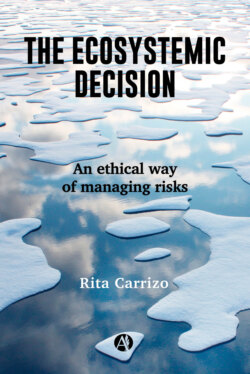Читать книгу The Ecosystemic Decision - Rita Carrizo - Страница 5
На сайте Литреса книга снята с продажи.
Introduction
ОглавлениеYou may have read the phrase “managing risks” in the title and approached this book looking for guidance on what, when and how to get your risks under control. You may even have been encouraged to discover the risks you are not managing today. If this is the case, you will probably be disappointed. There are no recipes or tools in this book that could bring you comfort. On the contrary, I dare say that much of what you will read in the next few pages will cause you considerable discomfort, and I will explain why.
Speaking about risks requires speaking about decisions. The decisions you make and those you don’t make are precisely the ones that produce the risks you want to manage. Therefore, from the perspective I will use throughout this work, you will notice that if you want to manage risks, you will first need to manage the decisions that lead to them. This task is not just about looking at the content of the decision itself, but fundamentally, understanding what drives you to make the decisions you make. You probably know people who make similar decisions to yours but who, in practice, undergo different impacts, outcomes, and consequences. This understanding opens the entrance to the rabbit hole; then you can go as far or as close as you want to.
If you read on, you will go down the decisional rabbit hole as deep as this author can go with her abilities and limitations. I propose you look at the decision by observing the decision-maker, the human being behind the decision. In particular, we will examine the decision-maker in Western culture. And this is where discomfort might arise, by seeing yourself personally reflected in this writing, when in fact all you wanted was a recipe. But if you made it so far, you may want to give yourself the opportunity to keep on reading, to judge for yourself whether there is anything you can learn from it. Nothing written here is going to change your decision-making attitude or your decisions, unless you want it to and allow it to. Don’t give my words that power; instead, give yourself the opportunity to reflect, to question yourself, and to question me. The rest is up to you.
The idea of “ecosystemic decision-making” could have piquet your curiosity and, just to fuel it, let me tell you that this book studies the Western decision-maker as a participant in an ecosystem where the decision-making process takes place, that is, immersed in a complexity from which he or she cannot escape. The journey down the rabbit hole begins with an understanding of the current situation of the decision-maker and the ecosystem duo; a panorama that I presume you will find familiar, though not necessarily comfortable. This is the intention of Chapter 1, a prelude to the insight that will follow in the next one.
You may find Chapters 2 and 3 like going downhill on a roller coaster: sometimes exciting, other times frightening, and sometimes you may wonder why you climbed on. Don’t worry, the same thing happened to me. Some stops are offered with the intention of integrating different perspectives of knowledge, including those within the fields of biology, genetics, sociobiology, and the ontology of language. I hope they help you make sense of the story and understand the decision-maker better. I also hope that they will pique your interest and, in your opinion, add rigour and theoretical underpinning to my perspective.
The descent and deep reflection culminate in Chapter 3, which offers a different path back to the surface, a path that proposes learning a new decisional paradigm that I have called “ecosystemic decision-making.”
Chapter 4 invites a closer look at the risk-taking decision-maker, drawing on advances in neuroscience and questioning the extent to which their decisions are deliberate or “rational.” The exploration ends with the “ecosystemic decision-maker” as the archetype of the new decisional paradigm.
At that point, and having developed the theoretical framework of the perspective, Chapter 5 takes on the task of reinterpreting some of the features of risk management discipline, starting with risk and uncertainty itself.
Finally, Chapter 6 attempts to provide a baseline for ecosystemic risk management, or ESRM, and to distinguish it from other traditional forms. It is offered with the intention of enriching knowledge, but more importantly, to be enriched by those who are interested and open to learning. This chapter also includes an appendix, written with the intention of showing how some decision-makers managed decisions during the pandemic COVID-19, which is contemporary to this text. It is not an ESRM process, but I hope it serves to show decisions that could have been ecosystemic but were not.
All this allows me to insist that this book contains no recipes, no critical paths, no new “truths” -you will then see why I say that. It simply offers a thoughtful, profound, and -as far as possible- informed view that seeks to give an interpretation -hopefully a powerful one- and offer it to the decision-maker.
